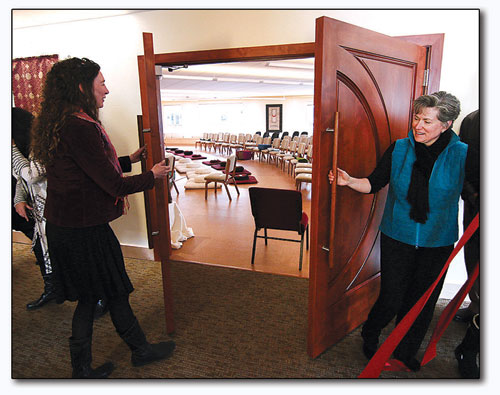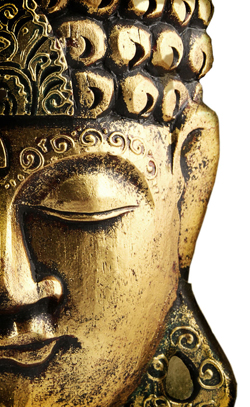
Durango Dharma Center Board President Jessica Denison, left, and dharma leader Maureen Fallon-Cyr, right, throw open the doors to the center’s new sitting room on Monday during a dedication ceremony. Since starting in people’s living rooms more than 20 years ago, the center has grown by leaps and bounds./Photo by Jennaye Derge
The great awakening
Surge in interest leads Dharma Center to bigger, permanent home
by Missy Votel
Just as Buddha found enlightenment after days of sitting under the sacred fig tree, the Durango Dharma Center has found a place where it, too, can sit and stay a while.
Just the FactsWhat: Durango Dharma Center open house |
This week, the nonprofit Buddhist teaching and meditation center hosted a dedication ceremony for its new center, located at 1800 E. Third Ave. The 6,000-square-foot space, former medical offices, was purchased and renovated solely through donations by the Dharma Center community, or “sangha.” Outgrowing its most recent location off CR 250, the center began looking for new, roomier digs a few years ago. The East Third property was purchased last spring and reconstruction to turn it from a compartmentalized office into an open, inviting space ensued.
When all was said and done, the estimated $1.2 million project includes a 250-person meditation “sitting” room, six bathrooms, a coat room, kitchen, library and various smaller rooms for meetings or to house guest speakers.
“I think the new space is so inspiring – I’ve seen so many smiles and tears over how gorgeous this place is, which has been done on such enormous generosity,” Durango Dharma teacher and leader Karherine Barr said.
Although the move is not surprising given the huge rise in mindfulness and meditation practices across the country, it is still a far cry from the group’s roots, which extend back some 25 years.
According to Barr, who became interested in Buddhism in 1995, in the early days, the sangha would hold its weekly meditations and talks in members’ living rooms. Early founders included former Cortez farmer Bill Manning (now of Grand Junction); Ethel and Ray Parker; Tom and Barb Klema; Katherine Leiner; and the late Hillary Pheasant. At the same time, the group also brought various Buddhist teachers to the area to offer retreats and give talks.
 The Dharma Center’s expansive sitting room. Located inside former medical offices at 1880 E. Third Ave., it has seating for 250./ Photo by Jennaye Derge |
As word got out, the Monday night gatherings and retreats grew, and the Dharma Center – dharma means “life” in Sanskrit – began a series of upsizing moves. It landed first at the Rocky Mountain Retreat Center, where it had room for about 25; then moved to a spot on Colorado Avenue off Florida Road; and most recently to a 1000-square-foot location on Metz Lane, next to Core Values Fitness.
“Within two weeks, we were already busting out of the seems there,” said Barr, adding that Monday nights typically draw 90 participants. This is in addition to the center’s talks, retreats and numerous other offerings.
Although the Dharma Center doesn’t keep cold hard numbers, board member Mary Nowotny said there are 500 people on its mailing list and 1,000 on its Constant Contact list. “It’s one of the best thing about the Dharma Center,” said Nowotny, “You don’t have to sign up.” Nevertheless, she said people feel a great “sense of belonging to a collective practice.”
The interest mirrors a growing national trend. According to a 2007 survey by the National Institutes of Health, out of 20 million adults, 2 million said they had tried meditation from 2006-07. This was a 1.8 percent increase from a similar survey in 2002. If the trend continues, by 2017, some 27 million people could be practicing in the United States.
Indeed, the “the mindful revolution” – as Time magazine coined it in 2014 – has touched all areas of American life, from Fortune 500 companies to the armed forces, helping to alleviate stress and anxiety and improve attention, concentration and well-being.
For Barr, who graduated from the Bay Area’s esteemed Spirit Rock Community Dharma Leader Program and has taught at the Dharma Center since 2000, it’s also about filling the void left by today’s fast-paced, digitized world. “There comes a time for most people – after their basic needs are met – that they ask, ‘Isn’t there something else? Isn’t there more to this life I’m living?’”
Barr admits the Buddhist teachings have had a “rocky translation” into Western civilization, but the core principles are the same: cultivating wisdom, compassion and connectedness. “Buddhist teachings, no matter what age you are, offer a path to live a life in a connected way. It has a lot of appeal to people who are searching for meaning.”
|
It’s all in your mind.No really …“Mindfulness” has become a buzzword these days, with everyone from Anderson Cooper to Rupert Murdoch reportedly taking up meditation training. Prac- titioners tout its abilities to thwart stress, anxiety and depression as well as improve attention, concentration and overall mental health. However, turns out it’s not just the latest trend du jour. A bevy of cold, hard scientific evidence suggests these claims just may be true, proving Buddha was on to something 2,500 years ago. It may not be a magic bullet, but among meditation’s proven benefits: - More gray for the graying – A 2014 UCLA study found subjects who’d been meditating for an average of 20 years had more gray matter that their nonmeditating counterparts – although older meditators still had some loss compared to younger ones. - Enough about me – A study at Yale found that meditation decreases activity in the default mode network (DMN), the “Me Center” of the brain responsible for mind-wandering – a.k.a., “monkey mind.” The DMN is “on” or active when we’re not thinking about anything in particular and is also associated with ruminating or worrying. Meditators were found to form new connections that quiet the DMN, and when the mind does wander, they are able to better “snap” it back. - Meditation not medication – Johns Hopkins researchers found that meditation had the same moderate effectiveness in reducing symptoms of depression, anxiety and pain as antidepressant drugs. - Be cool – In 2011, a team at Harvard found that regular meditation increases cortical thickness in the hippocampus (the area that governs learning and memory) while decreasing the size of the amygdala (responsible for fear, anxiety and stress.) Furthermore, a Stanford University team found that Mindfulness-Based Stress Reduction (MBSR) helps relieve symptoms of social anxiety. - Remember where you put your keys – One recent study found that just a couple weeks of meditation training improved people’s focus and memory on the verbal reasoning section of the GRE by an average of 16 percentile points. - Kick the habit – One study found that people who learned mindfulness were way more likely to quit smoking by the end of the training, and at 17 weeks’ follow-up, than those in conventional cessation treatment. This is likely because meditation helps “decouple” the craving from the act of smoking. Other research has found mindfulness therapy can help with other forms of addiction as well. – Missy Votel Source: The Atlantic |
New sangha member Sarah Taylor found herself doing just that about a year ago. The 35-year-old paralegal and mother of a teenage daughter said after being on the antidepressant Zoloft for years, she finally decided enough was enough. “I said, ‘I don’t want to do this anymore.’ So I got off it and that’s when I started meditating.” Since then, she said repeating her meta (similar to a mantra) for several minutes a day has taught her to be easier on herself and those around her. “It’s changed my life, with my way of thinking and compassion,” she said.
Barr said this is not unusual. With practice, meditation often helps people look inward, and learn to “respond rather than react.” “It teaches us to take a pause and not get so lost in our habitual patterns,” Barr said. “There’s a natural calming of the mind and body.”
Freelance writer Kate Siber, 35, has had a similar transformation since taking a beginner’s meditation class in 2013. She then joined the now defunct “Next Gen” mindfulness group and before long, was signing up for her first weeklong retreat. Like many, she was apprehensive at first. “The thought of sitting in silent meditation for several hours a day sounded completely crazy,” she said. “But it has been really beneficial.”
She said it is hard to quantify the benefits, but for starters, she feels calmer, has better concentration and is more resilient to stress. “It makes the wild ups and downs of being human easier to tolerate,” she said.
Regular practice can also bring more clarity to one’s actions and habits – for better or worse. “It can help you more clearly see a lot of things, particularly in your own behavior,” said Siber. “It can be a challenging practice and can make you see some things that are unpleasant. But ultimately, even the hard stuff can wind up serving you.”
Of course, while self-introspection is a big part of Buddhist teachings, one’s connection to the rest of the world is perhaps even more important.
“Ultimately it helps cultivate things like wisdom, compassion and kindness, which – let’s be honest – feel pretty good in and of themselves and ultimately benefit others and the world around us,” said Siber.
For example, the center practices the Buddhist tradition of “dana,” the act of reciprocal generosity. Although the meditations and talks are offered free or for a nominal cost, attendees are asked to donate to the “dana box” as a way to pay thanks and “pay it forward,” so to speak.
“Traditionally, the lay community around a monastery would offer dana, in the form of a daily meal, during the monks’ alms rounds,” said Barr. “It’s considered a privilege to offer monks food, and then in turn, the people receive teachings from the monks.”
She also noted the Buddha was adamant about making his teachings accessible to all. As such, talks and events are open to anyone, and the center also can cater to individual needs or groups, from 12-step programs to senior citizens. “There are so many different offerings, if there’s a group that wants to come together and incorporate Buddhist teachings, we’ll help them out,” Barr said. “Anyone can come, we have at least one or two there for the first time every Monday. Buddha called them the ‘stream enterers,’ just step in wherever you are on your path.”
And for the most part, it’s done purely on a volunteer basis. Barr said very little money actually leaves the center, with a small amount going to the web designer and the center’s four dharma leaders getting a percentage of the dana. The rest goes into operating the center and its programs, which incidentally are growing by the day.
It’s a momentum that Nowotny hopes will continue. “We see everyone from people in their twenties to people in their eighties and everything in between,” she said. “Our hope and goal is to continue to attract all comers. With the new space, it means so many more people can gain access … If you build it, they will come.”
The Durango Dharma Center holds weekly sittings and “Dharma Talks” Mondays from 5:30 – 7 p.m. A six-week beginning meditation class begins Wed., Feb. 3, from 6 – 7:30 p.m. To learn more about these or other programs, go to www.durangodharmacenter.org.
In this week's issue...
- May 15, 2025
- End of the trail
Despite tariff pause, Colorado bike company can’t hang on through supply chain chaos
- May 8, 2025
- Shared pain
Dismal trend highlights need to cut usage in Upper Basin, too
- April 24, 2025
- A tale of two bills
Nuclear gets all the hype, but optimizing infrastructure will have bigger impact

